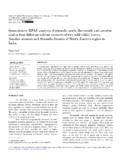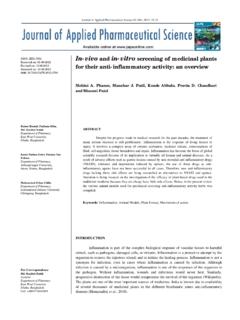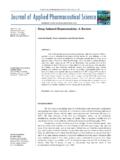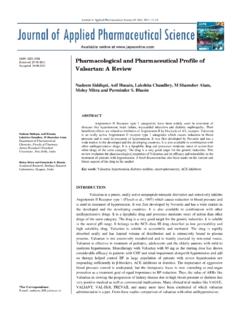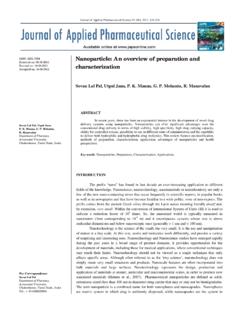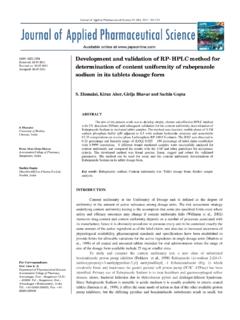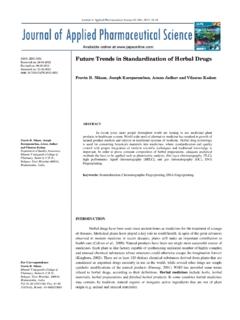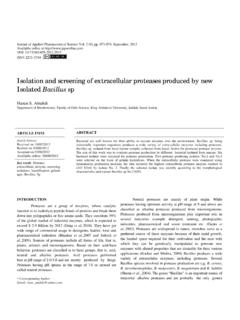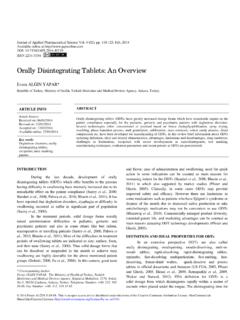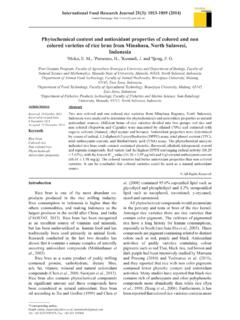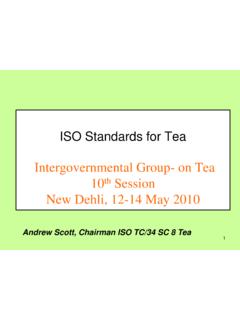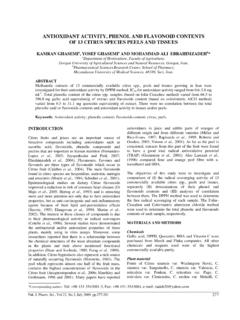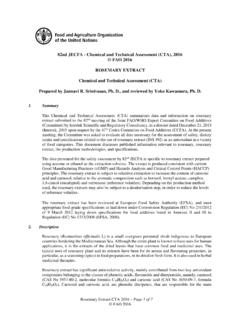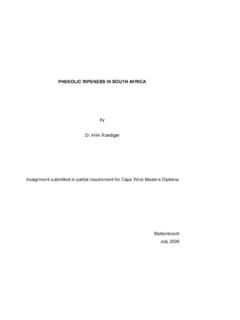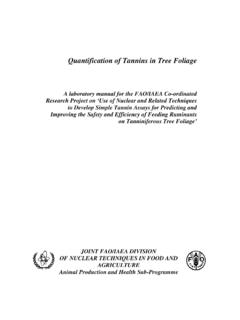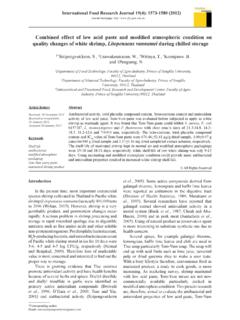Transcription of Total Phenolic, Total Flavonoid, Tannin Content, …
1 2015 Ahlem Rebaya et al. This is an open access article distributed under the terms of the Creative Commons Attribution License -NonCommercial-ShareAlike Unported License ( ). Journal of Applied Pharmaceutical Science Vol. 5 (01), pp. 052-057, January, 2014 Available online at DOI: ISSN 2231-3354 Total phenolic , Total Flavonoid, Tannin content , and Antioxidant Capacity of Halimium halimifolium (Cistaceae) Ahlem Rebaya1*, Souad Igueld Belghith2, B atrice Baghdikian3, Val rie Mahiou Leddet 3, Fathi Mabrouki3, Evelyne Olivier3, Jamila kalthoum Cherif1, 4, Malika Trabelsi Ayadi 1 Laboratory of Applications of Chemical Resources, Natural Substances and the Environment (LACReSNE), Faculty of Sciences of Bizerte, 7021 Zarzouna - Bizerte, Tunisia.
2 2 Preparatory Institute for Engineering Studies of El-Manar El Manar II - 2092 Tunis, Tunisia. 3 Laboratory of Pharmacognosy and Ethnopharmacology, UMR-MD3, Faculty of Pharmacy, Aix-Marseille University, 27 Bd Jean Moulin, CS 30064, 13385, Marseille cedex 5, France. 4 Preparatory Institute for Engineering Studies of Tunis, 2 rue Jawaharlal Nehru, Monfleury, 1008 Tunis, Tunisia. ARTICLE INFO ABSTRACT Article history: Received on: 23/10/2014 Revised on: 12/11/2014 Accepted on: 09/12/2014 Available online: 30/01/2015 This study was carried out to evaluate the phytochemical constituents and antioxidant potential of the leaves and flowers extracts of Halimium halimifolium in order to validate the medicinal potential of this herb.
3 The antioxidant activity of alcoholic and aqueous extracts was evaluated using 2, 2-diphenyl-l-picrylhydrazyl (DPPH), 2, 2 -azinobis- (3-ethylbenzothiazoline-6-sulfonic acid) (ABTS) and ferric reducing antioxidant power (FRAP) assays. The Total polyphenol, flavonoid and Tannin content were determined according respectively to Folin-Ciocalteu method, Zhishen method and Broadhurst method. The leaves of H. halimifolium had greater antioxidant activity than flowers by DPPH and ABTS assays. The ethanol extract of the leaves exhibited the better antioxidant activity by DPPH assay (IC50 = ), the n-butanol by ABTS assays (IC50 = ).
4 As opposed to FRAP method the flowers had greater antioxidant activity as leaves. Ethyl acetate extract exhibited better antioxidant activity (IC50 = mmol Fe2+.g-1). The obtained results showed that the extracting solvent significantly influenced the antioxidant property estimations of Halimium halimifolium. The ethanol is a recommended solvent for extracting antioxidants from this plant. The antioxidant activity determined by DPPH, ABTS and FRAP demonstrated a linear relationship with their polyphenols, flavonoids and tannins content . Key words: Halimium halimifolium; Cistaceae; antioxidant activity; polyphenols INTRODUCTION Plants have always been used by humans to relieve and cure many diseases (Ramawat et al.)
5 , 2008). Today, in many parts of the world traditional medicine replaces conventional medicine (Winslow et al., 1998). With multiple biological activities, many medicinal plants have antioxidant activity that is attracting more and more the attention of several research teams for its role in the fight against several diseases such as cancer, the atherosclerosis, cerebral cardiovascular events, diabetes, hypertension, and Alzheimer's disease (Liu et al., 2003; Devasagayam et al., 2004). * Corresponding Author Ahlem Rebaya, Email: Tel: +216 52160816/Fax: +216 71 87 39 48 In order to enhance the Tunisian forest resources and develop new products with high added value, we are interested in the family of Cistaceae and particularly the H.
6 Halimifolium. It is a common medicinal plant in the Mediterranean (Zunzunegui et al., 2000; Ferraz., 2000) used as antispasmodic, to treat stomach pain and to expel intestinal gas (Zunzunegui et al., 2000). It is also present in the south and west of the Iberian Peninsula, Italy, Greece and northern Morocco (Zunzunegui et al., 2002). In Tunisia, H. halimifolium is distributed in the forest road of Ain Draham and in the dunes of Tabarka (Debazac., 1995). The selection of this plant was guided on the one hand by the indications of its traditional use and on the other hand by the fact that at present, there have been very little chemical and biological investigations done.
7 Rebaya et al. / Journal of Applied Pharmaceutical Science 5 (01); 2015: 052-057 053 The purpose of this study is to enhance the knowledge of the H. halimifolium collected in Tunisia. Various solvents with various polarity (ethanol, dichloromethane, n-butanol, ethyl acetate and water) were used to compare the extraction efficiency of antioxidants H. halimifolium. Ethanol was also included to test the possibility of replacing methanol with ethanol in order to reduce toxicity. The antioxidative properties of the extracts in rockrose were assessed by 3 in vitro methods such as DPPH (2, 2-dipheny-l-picrylhydrazyl), ABTS (2,2 -azinobis-3-ethylbenzo thiazoline-6-sulphonate) and FRAP (ferric reducing antioxidant potential).
8 MATERIALS AND METHODS Plant Materials The leaves and flowers of were collected in June 2012 from Sidi Mechreg (Sejnen) located in the northern parts of Tunisia. H. halimifoliumwas botanically characterized by Ilham Mallak Maalej (botanist at the Faculty of Sciences, Bizerte, Tunisia) and according to the morphological description presented in Tunisian flora (Pottier-Alapetite., 1981). Herbaria of these plants are kept in the Department of chemistry, Faculty of Sciences, Bizerte under the code number 12/HH/cis. Plants were dried at room temperature for half month in a dry and airy environment.
9 The dried samples were powdered and stored in the dark at a dry place until further use. Chemical Reagents Folin-Ciocalteu phenol, DPPH (2, 2-Diphenyl picrylhydrazyl) reagent were purchased from Sigma Aldrich ( St. Louis, MO, USA). Sodium nitrite ( % purity), Gallic acid and Catechin reagents were from Sigma Aldrich (St. Louis, MO, USA). Sodium carbonates is from Fluka Biochemika (Switzerland), concentrated hydrochloric acid (37%) and absolute methanol was purchased from Panereac Quimica Sa (Barcelone). Absolute ethanol ( % purity) is from Scharlab (European Union).
10 Extraction method The dried leaves and flowers (400g) were macerated with absolute ethanol at room temperature for 24 h. The solution was filtered and concentrated under reduced pressure at 50 C, yielding and g of crude ethanolic extract of H. halimifolium leaves and H. halimifolium flowers respectively. The extracts were suspended in MeOH: H2O (3: 7; v/v) and extracted successively with dichloromethane, n-butanol, ethyl acetate in this order. DETERMINATION OF Total ANTIOXYDANT COMPOUNDS Total polyphenol content The Total phenolic content was estimated by Folin Ciocalteu method as described by Singleton et al.
